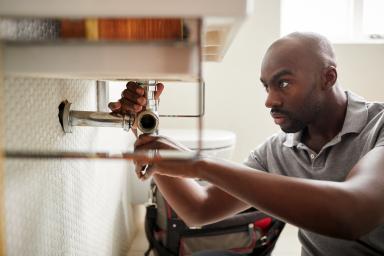How to open your own gym
Many fitness professionals and personal trainers envisage one day opening their own gym, or maybe even a chain.
All the big chains started somewhere and probably at some point a practitioner weighed up the various pros and cons of launching a business themselves.
In this article we’ll outline the different types of gym, what the costs are when looking to open a gym, and what qualifications you’ll need.
Is starting a gym a good idea?
Gyms are part of the UK fitness industry which is a growing sector of the UK economy.
In 2023 the market value of the fitness industry grew by 11.5% since 2022.
According to a survey conducted by Pure Gym, 79% of the UK public feel that their health has become more important to them over the last three years, yet 64% of people feel that they don’t do enough to look after their health.
Perhaps surprisingly, only 14% of people in the UK currently belong to a gym but that still represents an all-time high number of gym-goers in the UK
Those numbers also look set to grow as the same survey found a further 19% expect to join a gym in the next year.
Based on current population figures that could be over twelve million more potential customers for gyms across the country.
What are the different types of gym?
There are a variety of different types of gym that cater to different segments of the market. These include:
Big box gyms
Big box gyms stand out for their large, well-equipped spaces that cater to just about any workout need.
From swimming pools and saunas to a variety of group fitness classes, these gyms attract everyone from workout newbies to fitness pros.
Thanks to their vast array of equipment, members can enjoy the freedom to tailor their own workouts, making it easy to mix things up and keep routines interesting.
These gyms are usually part of a larger chain.
Boutique gyms
Boutique gyms are like the cozy coffee shop of the fitness world, offering a more personal and community-focused vibe than the larger, big box gyms.
They specialise in offering unique fitness classes tailored to different needs and preferences, from one-on-one sessions and small group workouts to strength training and high-energy HIIT classes.
The smaller class sizes mean gym goers get more attention from instructors, helping build a tight-knit community where everyone knows each other.
What really makes boutique gyms shine is their distinctive, welcoming atmosphere that keeps members excited to come back again and again.
Women-only gyms
These gyms are exclusively for use by female members and aim to provide a non-intimidating, friendly, and welcoming environment.
Women's fitness needs are unique, and that's where women-only gyms come in.
These gyms understand this difference and provide specialised classes and workouts, including popular Les Mills classes, to provide an enjoyable gym experience.
24-hour gyms
These gyms understand that everyone's schedule is different, so they're open 24/7.
This flexibility means you can hit the gym whenever it fits into your day or night.
With a focus on offering all the essential equipment and services, 24-hour gyms are perfect for people who are always on the go.
They're an ideal option for anyone looking for a gym that's always accessible, no matter their lifestyle.
Functional fitness gyms
Function fitness gyms and their fitness routines, like CrossFit, are all the rage thanks to their energetic, all-in-one workouts that boost fitness and strength.
Instead of focusing on just one area or muscle group like many gym workouts, CrossFit mixes up weightlifting with cardio moves for a well-rounded boost in overall fitness.
These gyms are known for their encouraging, team-spirit vibe, making workouts not only about getting fit but also about having fun and pushing each other to reach new heights.
Powerlifting gyms
Powerlifting gyms are the dream spot for those passionate about weightlifting.
Unlike big box or boutique gyms that have a broad range of gym equipment, powerlifting gyms are stocked with heavy-duty gear tailored for serious lifting.
Here, you'll find deadlift platforms, specialised powerlifting bars, and even competition-grade benches and squat racks designed to help weightlifters reach their potential.
How much does it cost to open a gym?
Opening a gym can have large upfront costs and a medium-sized gym could require as much as £100,000 up front capital to set up.
The cost of a running machine could be as much as £12,000, perhaps higher; and a standard gym might have 15 or 20 of them.
Now throw in rowing machines (perhaps £1000 each), exercise bikes, dumbbells (£500 a set), lifting machines, cross trainers (£800 each) and you could be looking at tens of thousands of pounds of machinery, at least.
You’ll need to be wise with your money and possibly shop second hand/refurbished, but still obtain machines that are safe.
Some sites sell refurbished machines at far lower prices, so these may be worth investigating.
You might also want to explore outlets, like Fitshop, that allow you to purchase gym equipment on finance.
Another option is to rent your equipment from companies such as Hire Fitness.
Purchasing on finance or renting can dramatically bring down your initial start-up costs.
There’s also the décor of the gym itself; you need at least two sets of changing rooms, but might also want sauna/steam rooms, and perhaps a swimming pool.
Gyms are typically laid out in a logical fashion, with related machines placed alongside each other in large, open-plan rooms.
If you’ll need to carry out extensive development, such as knocking down walls, it’s worth considering whether the building is the right one for your gym.
Should I open a franchise gym?
Looking to open your gym without breaking the bank? Consider joining a fitness franchise.
This option connects you with big-name fitness brands, allowing you to set up shop at one of their locations.
This way, you get a jumpstart on finding the perfect spot and tapping into an existing customer base.
Learn more about franchises.
Should I rent or buy when starting up a gym?
Choosing the actual building itself is not easy, and there are pros and cons for both leasing and owning a buildings.
Either way, you need to carry out an extensive amount of research into the area.
Most personal trainers start working as part of a gym chain and then move out to start their own business if and when they believe the time is right, so this is a good time to complete some on-the-job research.
Visit other gyms, seek advice on what other owners looked for, and don’t jump in on the wrong building on a lease that may punish you if you break the contract early.
If you feel you need to buy a property, save and build up a deposit as well as your credit rating, until you’re confident you’ll be able to get a commercial mortgage, and make sure your accounts are up to date.
You’ll probably need a deposit of at least 25%.
An online search will reveal that there are a large number of gym-suitable premises available up and down the country for rent or sale, which need little or no work, on a leasehold or freehold basis.
Many are sold as going concerns, meaning that you would take over ownership but not need to necessarily change the layout.
Some may come with planning permission to extend the premises.
Also, be aware that some sales are for the franchise only and not ownership of the premises themselves.
When taking over a gym, make sure you find out all the crucial details, such as the number of members, the current fee structure, typical utility bills, offers that have worked before, and so on.
While scouting for the perfect location, keep an eye out for a few key features:
- ample parking to make visits hassle-free
- a spot for a cafe or seating area where members can relax
- adequate space for locker rooms and showers for member convenience
- lifts and accessibility features for individuals with disabilities
- office space for handling administrative tasks
- potential for expansion to grow your business
- Complementary businesses – once you’re established you may sublet to nutritionists, physiotherapists, specific trainers (eg sports), yoga teachers, and others
- Could you ever add space to the gym if it becomes popular? Would you ever want to add a swimming pool or area for specific sports?
- Will you appeal to a specific niche of customer, or will it be a more general membership?
- How will you market yourself?
The position of the building should also be considered.
Would you like a city centre location or out-of-town? Is the access acceptable for the elderly or disabled? Think carefully about these issues when making your decision.
How to find the right location for your gym
Choosing the right spot for your gym is super important.
The IHRSA, the trade organisation tasked with growing, promoting, and protecting the health and fitness industry, found half of the people who join a gym end up leaving within the first six months.
The reason for the lapsing membership is mainly down to the gym being too far away or difficult to get to.
In addition to finding the right location for your gym you’ll also need to make sure that the building you choose has enough space.
When planning the size of your gym, a good rule of thumb might be to aim for 10-15 square feet per person, excluding communal areas and restrooms.
This guideline suggests you'll need about 1,000 to 1,500 square feet to accommodate 100 members each month.
Remember your location can have a serious impact on the amount you’ll need to charge your customers and rental costs can vary dramatically between a city centre location and one on the outskirts of town.
What qualifications do I need when opening a gym?
The first step to becoming a fitness trainer is the Level 2 Certificate in Fitness Instructing, to be followed by the Level 3 Certificate in Personal Training.
These can be completed in the gym, perhaps as part of an NVQ to allow you to learn on the job, or from home.
As well as learning about anatomy, nutrition, safe exercising and the other nuts and bolts of maintaining a body, you may also wish to take additional courses that can teach you more about the business side of running a gym.
If you’re planning to open up additional classes, such as boot camps, boxercise, and indoor cycling, then consider taking courses in these areas to boost your REPs (Register of Exercise Professionals) points and bring in more customers down the line.
Rules and Regulations when starting up a gym
When opening a gym, you should be conscious that you will be subject to legal and regulatory requirements, including health and safety legislation.
If you’re thinking about opening a gym, it’s a good idea to first seek professional legal advice to make sure you’ve got everything covered.
Types of insurance
When your clients complete their fitness questionnaire when they register, a waiver should be attached that obliges clients to recognise the risks of using a gym, and that the personal trainer/gym assistant/company will not be held responsible in the event of injury.
For the company, a number of different business insurance policies will apply, such as:
- Public Liability Insurance: This covers legal costs and compensation payments claimed by a third party, such as a member of the public for an injury they suffer – in a gym environment.
- Employer’s Liability: Cover for any staff who injure themselves in a way caused by work or the workplace, such as tripping over a weight or rope.
- Buildings/contents insurance: You will not need buildings insurance if you do not own the premises, but contents insurance is essential for your equipment. This could protect damage to, or theft of, weights and machines, laptops, and other equipment.
- Cyber insurance: To protect against cyber-hackers accessing clients’ files, bank details etc. Many gyms have electronic passes and cards that record data on clients’ attendance as well.
How do I Find Employees?
A small gym might need 2-3 employees, with various levels of qualifications, although this somewhat depends on the budget.
Successful gyms tend to have instructors with a range of skills and approaches, so it is sometimes beneficial to have a blend of genders, ages, experiences and specialisms.
All employees should have their Level 2 qualification or at least be training for it.
Also, think about whether you'd prefer to bring people on board as employees or as independent freelancers.
If your classes are only a few hours each week per instructor, hiring freelancers could be more cost-effective for your budget.
Learn more about hiring employees.
Learn with Start Up Loans and help get your business off the ground
Thinking of starting a business? Check out our free online courses in partnership with the Open University on being an entrepreneur.
Our free Learn with Start Up Loans courses include:
- Entrepreneurship – from ideas to reality
- First steps in innovation and entrepreneurship
- Entrepreneurial impressions – reflection
Plus free courses on climate and sustainability, teamwork, entrepreneurship, mental health and wellbeing.
Tags relating to this content
Disclaimer: The Start -Up Loans Company makes reasonable efforts to keep the content of this article up to date, but we do not guarantee or warrant (implied or otherwise) that it is current, accurate or complete. This article is intended for general information purposes only and does not constitute advice of any kind, including legal, financial, tax or other professional advice. You should always seek professional or specialist advice or support before doing anything on the basis of the content of this article.
The Start-Up Loans Company is not liable for any loss or damage (foreseeable or not) that may come from relying on this article, whether as a result of our negligence, breach of contract or otherwise. “Loss” includes (but is not limited to) any direct, indirect or consequential loss, loss of income, revenue, benefits, profits, opportunity, anticipated savings, or data. We do not exclude liability for any liability which cannot be excluded or limited under English law. Reference to any person, organisation, business, or event does not constitute an endorsement or recommendation from The Start-Up Loans Company, its parent company British Business Bank plc, or the UK Government.
Your previously read articles
Apply for a Start Up Loan
We've helped over 100,000 businesses get off the ground with a Start Up Loan. Can we help make your business dream a reality?
Find out more for a start up loan
Essential guide to starting a business
Our Essential Guide to Starting a Business is your roadmap to turn your business idea into a reality.
Across 12 chapters, you'll discover a wealth of information designed to empower and equip you with the knowledge needed to successfully launch and manage your new venture.
Sign up for our newsletter
Just add your details to receive updates and news from Start Up Loans
Sign up to our newsletter


